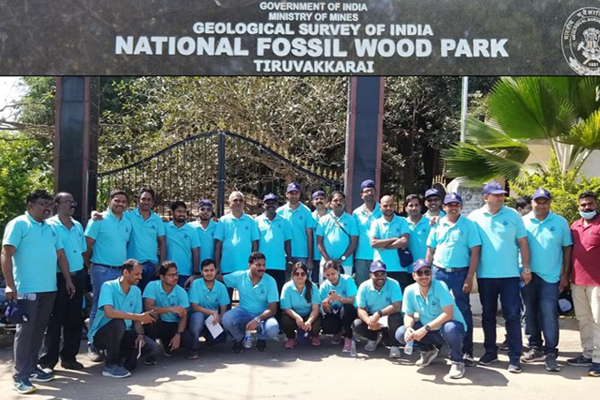
Society of Petroleum Geophysicists (SPG), Chennai Chapter organizes a One Day Field visit to Thiruvaakarai for Geo-Scientific Fraternity
Geo-scientific field trips are essential for geoscientists as they provide a hands-on, experiential learning opportunity. They allow geoscientists to study and observe physical features, geological structures and landscapes in the field. Field trips provide real-world experience and they enable Geoscientists to appreciate the complexity of the earth and the forces that shape it.
As a part of sharing invaluable field experience to the members, SPG Chennai Chapter organised a One Day Geo-Scientific field excursion on 05.02.2023 (06.00 hrs to 20.00 hrs) to understand the various geological formations in and around Thiruvaakarai, Vilupuram District of Tamilnadu.

A team of 27 Geoscientists from SPG, Chennai Chapter led by President Shri. K. Baskaran, GM(GP) along with Vice President Shri. K. Velu, GM(GP), Secretary Shri. Jose Antony, DGM (GP) and Shri. P. Arumugam, GM(G)-Block Manager, Cauvery Basin, SPG members from KG-PG Basin, Cauvery Basin, GPS & RCC, Chennai participated in the Geo-scientific trip. Prof. (Dr.) B. Gowtham, HoD, Govt.
Arts College (Autonomous), Coimbatore having more than twenty years of experience in Geology of Tamil Nadu, accompanied the team as an expert to co-ordinate the field trip. The team assembled at ANORC Campus in the early morning of 05th February, 2023 and started their journey to Contact of crystalline and sedimentary formations - Hard Rock Outcrops (Granite Mine) - Sedimentary Horizons - Fossil Wood Park rout at Thiruvakarai, Tamil Nadu.
The field trip began with a visit to contact zone of hard rock and sedimentary region near the Thiruvakkarai village (Location-1) around 10.30 am. The team was exposed to hard charnockite terrain of Archaean / Proterozoic age through outcrops in this region. Within a distance of 30 meters along eastern direction, red sandstones of Mio-Pilocene (Also known as Cuddalore Sandstone) are seen. These sandstone formation runs in N - S direction in an irregular pattern. This forms a contact zone between Hardrock and sedimentary terrain of Tamil Nadu.

The field team then reached Black Granite mine (Location-2) owned by Tamil Nadu Minerals Limited (TAMIN) which is around 500 meters west of location 1 around 11.30 am. Shri. Balamurugan, Manager, TAMIN accompanied the team to the abandoned black granite mine which is discordant intrusive igneous rocks formed in the later age between Charnockite rocks of Proterozoic age. This black granite (Dolerite dykes) runs with 30 width and 15 kilometers length in the west to east direction.
Shri. Balamurugan explained the geology of the dykes, method of drilling and its market value (High Export Quality rock type at International level) which have gained huge financial resources to the State of Tamil Nadu. The dolerite rock is hypabyssal rock (found at intermediate depth) made up of minerals like plagioclase feldspars, quartz, biotite, and brown hornblende.
Next, the field team proceeded to a palaeo river bed located around 1 km in eastern direction completed made up of Mio-Pilocene sandstones - Cuddalore Sandstones - exposed (Location-3) as small mound around 12.30 am. The bedding structure of this sandstone clearly shows the direction of flow during mio-pilocene period. In few places cross bedding structure which are due to different direction of flow in different seasons are witnessed. The red sandstone with more than 20 meters thick is made up of boulders, pebbles of different sizes.
The uniqueness of these tertiary sandstones is they carry many wood fossils from north western part. Huge trunks of trees have been carried away by these sandstones to this location in the geological past.


After studying the red sandstones in the river bed, the team reached the final destination and most expected location (Location-4) Thiruvakkarai Wood Fossil Park (notified National Geo-Heritage Monument by Geological Survey of India (GSI) ) nearly 700 m west around 14.00 pm. The park hosts about 200 petrified wood fossils approximately 20 million years old, scattered throughout the park.
The park consists of nine enclaves, but only a small portion of the 247 acres (approx 1 square km) is open to the public. Many number of wood fossil brought by the river remain in its original state of deposition and a few wood fossils are arranged for display to attract the tourist. The field team had a detailed study in these wood fossils, the nature of palaeo-environment and flow direction of the river that had brought the huge trunks to this region.
Scientists speculate that some trees did not originally grow at the site, but were transported before they had petrified. The fossils are well preserved due to extensive petrifaction. The trees' annular rings and pit structures are clearly visible, allowing their age to be determined by counting the rings.


The group spent one complete day exploring the area, observed the various sedimentary and crystalline hard rock features of the area, and discussed the different aspects of geology that could be observed in the region. After visiting all the scheduled destinations, the team came back ANORC campus around 20.00 hrs. SPG Chennai Chapter is always promoting the technical activities. Chapter has offered such an event to all of its active members and encouraging new members to join SPG by participating in the event. Also, Chapter had offered the members/participants a welcome kit (includes T-shirt, Cap, Writing pad & Pen).
Overall, the trip was a great success, the daylong field trip was very educative to the participants and it definitely had given a real insight on the exposures and geology of the Thiruvakkarai area. They were also able to gain valuable insight into the different geological processes that were involved in the formation of the geological structure, as well as the geological history of the region.









